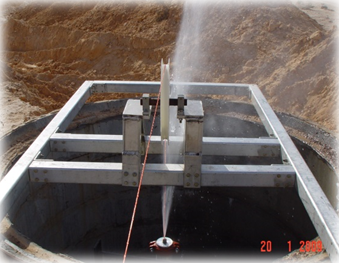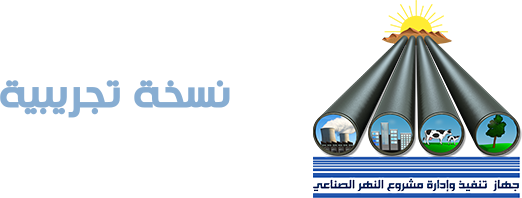Department of Planning, and Follow-up
Monitoring operational planning, programs, executive operations, and contracts within the project's systems and other branches manifested in timelines, periodical reports, and standard technical specifications of prestressed concrete pipes and related industries, all of that is to facilitate the working process, maintain quality, and supervise technical and contractual liabilities. Also submit proposals, prepare rehabilitation programs, checking, and monitoring plans for the on duty pipes, in addition to pursuing and checking manufacturing and installation data of the pipes listed in the hazards management and assessment automated system.
Department of Planning, and Follow-up is divided into 7 sub-managements which are manifested in 5 sub-departments, in addition to Brega and Assireer plants for concrete pipes with steel wire reinforcement production.
Tasks and responsibilities of planning and follow-up department
1. Pursue the execution of plans, contracts, and programs related to the manufacturing and transportation of pipes in order to maintain quality, and facilitate the working process.
2. Revise and adopt documents of work procedures, technical specifications, and charts related to the manufacturing of pipes and their accessories, as well as giving recommendations.
3. Revise and approve (PVC) papers pertaining to the manufacturing of concrete pipes and related accessories, after final acceptance of completed pipes.
4. Pursuing general timetables (level one), for under construction projects regarding time and cost, and constituting fully comprehensive schedule – level one – to disclose an exhaustive plan for projects both under-construction, and in queue.
5. Follow up the work of the advisory bodies and contractors implementing the works in the agency, assess the level of performance at various work sites, and prepare technical reports on them.
6. Follow-up and evaluation of the operational status of projects under implementation or contracted, and assess the progress of work on projects and compare them with time programs approved in contracts, diagnose difficulties and problems associated with them, and participate in finding solutions and remedies for them.
7. Collecting and analyzing data and information related to project implementation and preparing reports of the executive and contractual position for them.
8. Follow up the operational status of the components of the systems and centers and document the problems and difficulties associated with operation and maintenance operations within the records and models of problem management for the purpose of following up on them and finding appropriate treatments and solutions.
9. Study and follow-up of various inspection and monitoring techniques and non-destructive tests related to the assessment of concrete pipelines inside water transmission lines and the preparation of technical reports on them.
10. Following up on the development and updating of work methods in the agency by studying the development and specification of technical specifications for business information systems.
11. Collecting, analyzing, correcting and updating the manufacturing and installation data of concrete pipes in the various stages of projects of the agency and creating their own databases.
12. Preparing rehabilitation, inspection and monitoring programs for prestressed concrete pipes with the help of the automated risk management and evaluation system, identifying and analyzing the technical specifications of the information systems required for business and supervising the stages of their development and implementation.
13. Supervising the operation of the automated risk management and evaluation system, updating its database, carrying out the work of collecting and analyzing the results of the system outputs, and supervising and following up on the program for developing and maintaining various software for the automated risk management and evaluation system and other software in the device.
14. Executing detection, theoretical examination and non-destructive tests on concrete pipes located inside water transmission lines, and collecting and analyzing the results of the examinations and tests carried out on the pipes and verifying their correctness and accuracy.
Quality Control Department
The Quality Control Department prepares, follows up, monitors and ensures the effectiveness of quality systems in accordance with the ISO standard specifications, which will be applied in all branches of the systems, public departments and technical centers, in addition to evaluating manufacturers, suppliers, contractors, subcontractors and consultants to verify their compliance with the standard specifications by conducting internal and external audits.
The Quality Control Department is also concerned with evaluating performance and analyzing statistical data with the aim of continuous improvement of all operations of the agency to ensure the achievement of goals and access to excellence, in addition to spreading the culture of quality using various means.
Specialties and Responsibilities of the Quality Control Department
1. Preparing quality assurance systems and ensuring compliance with them.
2. Continuous improvement and development of quality systems in order to reach excellence.
3. Evaluating the quality systems of manufacturers, suppliers, subcontractors and consultants to verify their compliance with the standard specifications.
4. Evaluate the performance level of the various work sites in the agency and submit periodic reports on that.
5. Conducting inspection and auditing visits on the activities of the contractors contracted with the Agency to ensure their compliance with the requirements of quality systems and prepare reports regarding the issue.
6. Carrying out inspection and auditing visits to the activities of the agency’s departments, offices, centers and branches of the agency’s systems to ensure their implementation of quality systems.
Information Technology Management
The computer management and the connection networks cover all areas of technology and information systems in the agency, and the establishment, operation and development of a highly reliable information environment that contributes directly and mainly to improving the performance and productivity of the agency because it will provide support to the higher management in taking the correct policies and decisions in a way that ensures the achievement of the objectives and plans of the agency.
Specialties and Responsibilities of the Information Technology Management
1- Support and maintenance of hardware, software, equipment and connectivity networks.
2- Design, installation and maintenance of interconnection networks. 3- Study the needs and requirements for computer hardware, software, and networking equipment and work to provide them.
4- Supervising the design of programs and systems.
5- Securing the protection and confidentiality of the connection networks, devices, systems and vital data
6- Standardizing and disseminating the software used in the device. 7- Following up on scientific development in the field of software, hardware and networking, and submitting technical proposals to benefit from them.
8- Organizing the use and distribution of devices and networking equipment to serve the interest of the agency.
9 - Directing and rationalizing expenditures in this area.
Pipeline Monitoring Technology Department
The acoustic monitoring technology using acoustic sensors technology (Hydrophones) and the fiber optic technology (Fiber Optic) is the first line of defense for the Manmade River pipelines system, and one of the most important technologies that is based on early detection of the condition of these pipes in terms of breaks that occur in the pre-stressed steel wires which are fundamental for the industry in order to avoid the failures that may occur in the man-made river pipelines system along the two pipelines Assireer / Sirte-Tazirbo / Benghazi, as this technology depends on monitoring and early detection of the damaged pipe, to be intervened for the purpose of treatment.
As a result of previous experiences and failures that occurred in the prestressed concrete piping system, research and study efforts led to the introduction of the acoustic monitoring system and the administration's containment of these two types of technologies for implementation, operation and follow-up.
 FiberOptical FiberOptical |
 Hydrophone Hydrophone |
As a result of the failures on the two lines (Assireer / Sirte-Tazirbo / Benghazi) the need to use non-destructive detection and control techniques through which the system's pipes are tested and monitored to determine the pipelines' condition in terms of order of importance for programming repairs and intervention work and the use of data collected from detection and monitoring works as a database to analyze and make decisions based on those results.
Where the company, PURE TECHNOLOGIES, provided a program for monitoring the pipes using the technology of sound sensors (Hydrophones), through which the sounds occurring inside the tubes are recorded, then analyzing those sounds using a computer program and comparing it to the sound and energy released when the steel wire is broken, and then injecting these results with the Pipe Risk Management System (PipeRiskManagementSystem)
The idea developed and expanded the scope of monitoring using the aforementioned technology, and its effectiveness was investigated on several occasions during the intervention to repair the tubes by comparing the interruptions recorded at a particular pipe and what is found on the ground when drilling on that tube.
Despite the effectiveness of monitoring using acoustic sensors, it suffered from shortcomings represented in the limited distance to be monitored and the need to add many equipment to expand the monitoring range, as well as the frequent maintenance work of the audio monitoring equipment during the operation of the system.
As the company developed the acoustic monitoring technology which is based on passing optical fiber cable (FiberOptical) inside the tube during the flow of water to the main piping system for a distance of up to (40 km) and put a monitoring station data processing unit (OPDAS) in the entry room of the vehicles ( VehicleAccess) in the middle of the target distance in the acoustic monitoring process, through which data is collected and uploaded through the communication system for the purpose of its analysis, and all operations are carried out by engineers and technicians of the Department of Acoustic Monitoring Technologies, and support from the sites and the management of operation and maintenance, and this is done under the supervision of the aforementioned company.
 FiberOptical FiberOptical |
 Hydrophone Hydrophone |
Specialties and Responsibilities of Pipeline Monitoring Technology Department
1- Follow-up and supervision of contract work for the pipeline monitoring system on the two pipelines (Assireer / Sirte-Taazirbo / Benghazi) and future contracts for the Hassawna system and the Ghadames system.
2- Collecting and analyzing data on piping monitoring techniques and non-destructive tests used in the agency's system.
3- Evaluation of piping monitoring techniques and nondestructive tests of prestressed concrete pipes for water transmission lines.
4- Preparing the necessary plans to schedule the work of monitoring pipelines and non-destructive tests on the piping system.
5- Preparing periodic and technical reports, including proposals leading to ensuring the safety of the system of water lines.
6- Working on developing techniques for monitoring tubes and non-destructive tests in the agency’s systems.
7- Installing and maintaining the digital communication system and the expanded network to link all communications system with the data analyst to facilitate the analysis operations.
8- Supervising the implementation of industrial safety and security requirements to preserve lives, facilities and property and prevent losses.
9- Receiving contract materials, inspecting them and preparing them for installation.
10- Reviewing all payment requests of the implementing contractors and referring them to the competent department.
11- Carrying out other similar work assigned to it.



